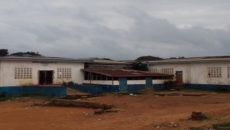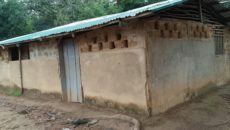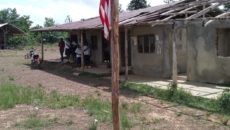Editor’s Note: This is a sponsored article
As an academic with a keen interest in seeing the practical development of Liberia’s new pro-poor focus, I was very intrigued by ZOA’s initiative to deliver a school meal program that sources food directly from local farmers and which harnesses the entrepreneurial energy of the private sector by working with agro-enterprises.
A day in a remote school in Margibi with all the key stakeholders present convinced me that this model has the potential to revolutionize school meals provision in Liberia, while boosting the local economy. Surely, an initiative worthy of greater investment.
With my research interest in food and nutrition security, livelihood enhancement, market and value chains development, traveling to Kakata, Margibi as early as 7:30 a.m. on a Monday morning was exciting. First, there would be interaction with policymakers in the Ministries of Education and Agriculture, in whose hands some of the decisions to potentially upscale this promising model rest. Second, I would, for the first time beyond the old LIBSUCO Building – which houses the Ministry of Agriculture – get a real-world opportunity to hear from agro-processors, a team of key players along the agricultural value chain.
At Dartu-ta Public School, about 15 minutes from the Kakata city center, the Ministry of Education is launching ZOA’s Local Agriculture for Nutrition in Education Value Chain model. So far, ZOA has raised over US$500,000 for this project from the Dutch companies, Vreugdenhil, and Hoogwegt Dairy Products, Turin Foundation and ECOWAS.
This demonstration project will run for the next three years and takes a holistic four-pronged approach to tackle low enrolment and attendance at school, and food and nutrition insecurity, by strengthening community resilience, developing agricultural value chains and promoting market access for farmers and agro-enterprises alike.
Building on previous initiatives funded by the European Union (EU Cassava Value Chain Development project and Pro Resilience Action) and ECOWAS (Improving Food Related Behavior on Value Added Cassava Products), ZOA’s LANE VC is a 36-month social safety net project that will achieve outcomes in the education sector as well as in agriculture and economic development.
There is no doubt that this project is needed. In 2016, the U.N. ranked Liberia as having the highest proportion of children out of school in the world. Currently, only 44 percent of primary age students are attending primary grades. The figures on nutrition and rural livelihoods are equally challenging; an estimated 44 percent of childhood deaths are attributed to malnutrition, making it the single most common cause of death of Liberian children. Despite having fertile soils, smallholder farmers in Liberia continue to have low yields and farmers tend to rely on a few crops, with poor access to markets.
In Liberia, the provision of school meals has depended almost entirely upon the importation of food, thereby offering nothing to struggling farmers and agro-enterprises. In contrast, ZOA aims to demonstrate that local procurement and processing of high quality, nutritious food for school meals in Liberia is possible, and desirable for whole range of reasons.
The project is tailored to provide a well-structured market alternative to smallholder cassava and vegetable farmers, thereby improving their livelihoods, and simultaneously to provide nutritious daily school meals for at least 5,800 children. There is an expectation that enrolment will increase by 25 percent, and that children will have more energy to participate fully in their lessons. Alongside this, two agro-processing MSMEs, Bravo Sisters and Destiny Women, will develop their business skills and create new jobs in their fledgling industries.
Holistic and Inclusive Development?
In Margibi, one of the five highly food insecure counties according to LISGIS HIES 2014, the project is expected to increase the volumes in cassava production by about 50 percent amongst the smallholders. There is also a new market linkage created through the purchase of cowpeas.
Whilst offering prospects on the economic fronts, the model will contribute to children enrolment and attendance in school and enhance their energy levels. The meals provide around 30 percent of the nutrition that a child needs each day, and provides essential vitamins and minerals that are commonly lacking among children in Liberia. Parents, many of whom struggle to make ends meet, will be relieved of the economic burden of compulsorily finding the first daily meal for their school-going children, and those who are farming will increase their income by selling to the agro-enterprises who will make the school meals.
At around US$20 for approximately 200 nutritious meals for each child annually, LANE VC appears to be costly from the periphery. But detailed analysis of its potential impact of contributing to reducing the current estimated US$250 million annual national food-related importation expenditures, by increasing local food production, makes it a venture worth testing.
Also, with increased coverage, the cost per child potentially reduces. The great benefit of this approach compared with the importation models, is that the funds invested stay in the Liberian economy, boosting the prosperity of Liberian farmers, rather than those of countries imported from.
“This model is holistic and involves everyone… it will substantially contribute to the local economy when optimized…†said Christian Nyemah Howbott, Sr., the optimistic-looking director of the School Feeding Unit, at the Ministry of Education, while acknowledging the contribution of other service providers, during the official launch statement.
In Nigeria, for example, Home-Grown School Feeding has contributed to the creation of about 68,000 jobs. Same has begun with ZOA’s chain of intervention in value addition. Ms. Comfort Lovo Jallah, Managing Executive of Destiny Women, – one of the two agro-enterprises participating in the pilot – signaled a 50 percent increase in the number of available jobs at the processing facilities. Also, “sales agents have reached a record number of 15, since the recent effort,†she added.
Sustainable?
In other developing economies, models of Home Grown School Feeding have been piloted, but their level of sustainability, have proven challenging. In Nigeria, for instance, a pilot was launched in 2005 in 13 states, but was maintained by only Osun State. Thus, in 2015, the Government of Nigeria re-instituted Home Grown School Feeding as part of a comprehensive national social investment program (ibid). LANE VC recognizes the associated challenges and has consequently incorporated a sustainability package pillared around social, institutional, financial and environmental components.
For ZOA, developing woodlot helps replace the trees felled for charcoal production, which provides energy for the meal preparation. They have therefore innovated this method of reforestation, as an environmental sustenance approach, into the pilot.
Socially, community ownership is prioritized. Parents and teachers, through the PTAs, students and community members are trained in many areas including: safe and hygienic food preparation methods, nutrition, health and WASH, gender and social inclusion of people with disabilities, stock management and school gardening to educate children on the benefits of vegetable production.
LANE VC foresees institutional sustainability in the training of agro-processors, smallholders – who are ambassadors and can share knowledge with peers – and the MoE and MoA in aspects of delivering the school meals at a standard level.
Whilst this model lends opportunity for better community ownership, financially, however, there is a constant need to source funds for the purchase of the produce from smallholder farmers. This is where, the leadership of the government is most required. ZOA rallies the support and involvement of the GoL and development partners.
Like Benin, where the government allotted US$47 million to support World Food Program to feed 400,000 children for five-year period, by creating a budget line for home grown school meals, the Liberian government would demonstrate its commitment to food and nutrition security, education, poverty reduction and job creation.
The MoE, with base support from the Ministry of Agriculture – and eventually Commerce and Gender, Children & Social Protection –, assumes the responsibility to lead the intra-governmental networking to firstly secure a budgetary line for home grown school meals. This may be achievable, over the next medium-term, per authorities’ unofficial prediction. But with the recent pro-poor approach taken in the 2017/2018 recast budget – i.e. shifting portion of the recurrent cost, in the tone of $9.6 million to public sector investment projects – there is much more hope that, with sustained inter-sectorial engagement and coordination, GoL could, following initial results of the pilot, begin to line-in school feeding in the MoE budget for FY2019/2020.
But also, too, the larger school meals implementers, Mary’s Meals International (MMI) and World Food Program (WFP), both of whom rely on imports, have already set their eyes on replacing imported food with home grown produce. MMI which operates in a third of Liberia’s 15 counties and caters for 114,000 children in 513 schools, is well positioned to switch to local procurement, with potentially huge benefits for local farmers and businesses. The Country Director of Mary’s Meals Liberia, Emmanuel Kailie, in a conversation on the margins of the launch, referenced previous efforts to source food locally, noting that this can be challenging due to failures in the supply chain. The WFP is also piloting a home-grown approach in Nimba County. It seems clear that the overall direction of travel by development partners is towards a home-grown approach, and the invitation is there for the Government to throw its weight behind these initiatives.
ZOA’s Country Director, Chris MacLullich, emphasizes that this initiative has been developed through close collaboration with the MoE and MoA, and that the sustainability of this model depends on high quality execution and real tangible outcomes for children, farmers and local businesses. He underlines that it will be necessary to demonstrate that consistent supply of high quality, safe and nutritious foods from the farmers and processors is possible, in order to achieve substantial up-scaling and adoption by the big players. He says that whilst this comprehensive and holistic approach requires expertise and commitment, the multiple benefits make the effort worthwhile. “ZOA will have an ‘open door’ approach to all interested parties and will deliver workshops on the methodologyâ€, he added.
Overall, a number of factors, including: the existing policy framework, limited agricultural extension, scale of production (smallholders rather than plantations), limited food safety measures (affecting the quality of locally produced food), cost relativity (i.e. local procurement seemed costlier than importing food), lack of structured and sustainable market (which affects demand consistency), are assessed to have hindered the progress of previous efforts. And so, a model that lures this level of systemic coordination could just be the key to addressing the problems.
Conclusion
At Dartu-ta school in Katata (Education) District – the six-classroom structure, built by ZOA in the aftermath of the civil conflict, now housing nine classes (Nursery, including Kindergarten 1 and 2 to Grade 6) – despite the heavy rain, there is a buzz of excitement as children and visitors eat ‘Garioco’ and Milky Gari for the first time together. Volunteers in the kitchen, which has been built by the community, are enjoying contributing their time in a healthy environment as the ZOA-designed smoke free stoves have chimneys. The launch has attracted delegations from the Ministries of Education and Agriculture at both County and National level. Agro-businesses are present as well as scores of community members and teachers from neighboring schools. International NGOs are also represented, including Concern Worldwide, Street Child Liberia, Mary’s Meals, More than Me, Agri-corps, Welthunger Hilfe, and JUST. Important conversations are being held between these stakeholders, and there is noticeable excitement as the participants share a great sense of possibility and potential for HGSM. This LANE VC could be the point to harness the required synergy.
Towards addressing the quadripartite issues of poverty which stands at about 54 percent, hunger and malnutrition in children caused by the 49 percent national food insecurity level (ibid), the 62 percent high rates of children being out of school, and 89 percent of Liberian businesses employing under 20 people, a comprehensive government-inspired policy and programmatic approach is required – and ZOA’s LANE VC model seems to be a major piece derived for the puzzle.
LANE VC, when comprehensively gauged, seems a complex, yet possible task. Albeit, contributing to the SDGs through: Goal 2: end hunger; Goal 3: health and wellbeing; Goal 4: quality education; Goal 6: clean water and sanitation; Goal 8: good jobs and economic growth; all of which lead to achieving Goal 1: end poverty; this model deserves greater and keener attention beyond the Liberian policy landscape.
Editor’s Note: This is a sponsored article. Featured photo by Margreet Noordhof





